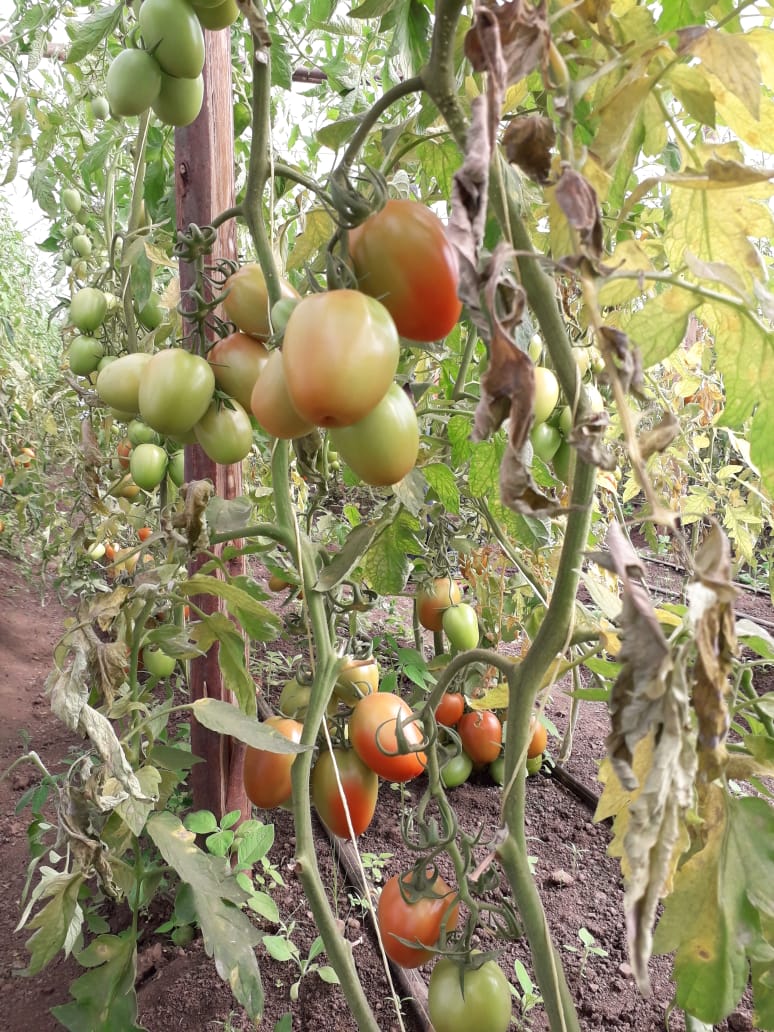 Riping tomatoes at part of Livingstone Ng’ang’a's farm in Laikipia County. The farmer produces 360 boxes of tomatoes per season targeting dry season when the crop is in high demand and low supply for more income. Photo courtesy.
Riping tomatoes at part of Livingstone Ng’ang’a's farm in Laikipia County. The farmer produces 360 boxes of tomatoes per season targeting dry season when the crop is in high demand and low supply for more income. Photo courtesy.
A law graduate from Mount Kenya University (MKU) is making over Sh4.2m gross income a season from tomato farming by avoiding rain-fed farming practices and middlemen, the two factors that are reportedly causing glut and poor pricing of the produce in the Kenyan markets dwindling farmers’ earnings.
A according to a October 2015 Kenya Agricultural Risk Assessment report by World Bank, over reliance on rain-fed agriculture has been seen as one of the major causes of food insecurity in the country while overproduction of most farm crops during rainy season courses glut affecting market prices.
On the other hand, according to a 2016 Special Report by Kenya Market Trust, although brokers are important players in food chain, their high fees and other market informal levies affect farmer earnings and consumer prices.
But for Livingstone Ng’ang’a, a farmer from Ng’arua village in Laikipia County, growing tomatoes on irrigation and ferrying the crop to the market after harvesting has been his tactics of earning more from the venture.
“I always grow my tomatoes towards the start of dry seasons and I depend on water to irrigate them. By mid of the dry season when there is always high demand and low supply I would start harvesting and transporting them to market to record good income,” said Ng’ang’, the 2017 Bachelor of Law (LLB) graduate.
He says as much as during rainy season there is outbreak of pests and diseases that also affect production, water is very important in tomato production.
“Irregular watering together with lack of calcium may lead to blossom end rot. Erratic irrigation may also result in cracking and splitting of fruit skin leading to losses,” said the 24 years old farmer.
Ng’ang’a started farming in 2013 on a section of one and a half acre piece of plot he acquired form his parents while still an undergraduate at MKU. This was to be his source of pocket money while in and out of school.
RELATED CONTENT: Disease resistant new tomato hybrid can earn Sh3 million
During one of his long vacation period, he attended a farmers’ training in the county and heard about Shanty Improved F1 tomato variety from Amiran Kenya Ltd, an agro-dealer company in Kenya. He then decided to try commercial tomato production owing the training he got.
“I bought 12, 500 seeds from an agrovet shop in Laikipia town at Sh36, 000 then spent other cash on drugs, fartiliser and labour,” said Ng’ang’a.
This happened at a time when tomato farmers in the country were recording low yields due to tomato nematode disease which cause distinctive galls on the roots, reducing roots capacity to supply the vine with water and nutrients, leading to stunted growth, yellowing or wilting.
But all these did no discourage him.
“I wanted to take the risk having listened to the agronomists from Cooper K-Brands Ltd (CKL) who offered the trainings and suggested a number of tomato varieties of which I was impressed by Shanty F1 because of its qualities,” he said.
RELATED CONTENT: New tomato variety resists nematodes
Apart from being tolerant to the root disease, this variety of tomatoes has high yielding potential and do well both greenhouse and open field. It also takes 75 days to mature as opposed to other varieties like money maker which take up to 90 days.
In addition, the variety has a shelf life of 14 days due to its tough skin something Ng’ang’a says has helped him sell for long limiting post-harvest losses.
Today the farmer is harvesting 360 boxes of tomatoes per season and ferry them to the market using lorry he hires from his friend at a discounted amount.
His major markets includes Nairobi’s Muthurwa market, Daraje Mbili in Kisii County and Rongo market in Migori County. He harvests 1080 boxes of tomato in three seasons annually.
RELATED CONTENT: Tomato turns Western students into entrepreneurs
In a good season he sells a box at Sh6000 giving him about 2.2 million shillings. This translates to more than 6.5 million shillings gross income annually. His four workers, transport and other expenses takes away about 2.2M leaving him with a net profit of over 4.3M annually.